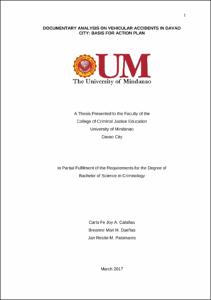Documentary analysis on vehicular accidents in Davao City : basis for action plan

View/
Date
2014Author
Calañas, Carla Fe Joy A.
Dueñas, Breanne Mari H.
Palomares, Jan Restte M.
Citation Tool
Metadata
Show full item recordAbstract
This research paper was conducted to provide a documentary analysis
of crimes involving R.A. 9165 in Davao City for the year 2009. The
researchers employed a descriptive survey method, and an electronic copy was
obtained from Davao City Police Office (DCPO) as the source of data. The
statistical tools that were used by the respondents were Frequency and
Percentage used to analyze the research result. The findings of this
study revealed in terms of the profile of neutralized drug persons in Davao
City for the year 2009, the majority of them are drug users with 63 individuals
neutralized or 60 percent while drug pushers accounted for only 39
individuals or 37 percent. Cocaine accounted for most of the drug seized in
terms of quantity with 16 kilograms, which was followed by Marijuana dried
leaves with 3.7 kilograms. In terms of the status of cases of persons involved
in R.A. 9165 in Davao City for the year 2009, 100 percent are already filed in
trial courts in Davao City, and its status is still on trial and pending
resolution. Further, in terms of the status of suspects involved in R.A. 9165 in
Davao City for the year 2009, all suspects, or 100 percent are presently
detained in different prison cells. Most of the evidence seized was
communications equipment (60 percent) and also vehicles (40 percent).
These are aside from the drugs that were also seized or confiscated.
Collections
- Undergraduate Theses [639]
Publisher
COLLEGE OF CRIMINAL JUSTICE EDUCATION
